Painful Shoulder – Impingement Syndrome?
There are a few common causes of a painful shoulder. They include:
- Shoulder impingement syndrome.
- Shoulder rotator cuff tear.
- Frozen shoulder (adhesive capsulitis).
In this post, I will talk about shoulder impingement syndrome.
What is Shoulder Impingement Syndrome?
There is a small space between the head of the upper arm bone (humerus) and the acromion (a bony projection from the top of the shoulder blade) that the rotator cuff tendon passes through and the distal end of the collar bone (clavicle).
If the rotator cuff tendon becomes inflamed (tendonitis) and swell, it may not have enough room and may get squeezed. This is called impingement syndrome. This further irritates the tendon.
The pain is brought on by overhead activities or movements.
In sports, it is associated with racket or ball games with repetitive overhead serves, smashes and spikes.
Why is the Shoulder Painful with Overhead Activities?
Raising the arm overhead causes the head of the upper arm bone (humerus head) to slightly rise on the shoulder socket (glenoid) and narrows the space between the head of the upper arm and acromion causing contact between the rotator cuff tendons and the roof of the shoulder blade.
Activities (such as swimming, tennis) that involve repetitive overhead arm movement cause repeated contact and friction between the rotator cuff tendon and the undersurface of the acromion, and may cause irritation and inflammation of the tendon.
Some people as they grow older develop bony spurs in the anteroinferior aspect of the acromion (roof of the shoulder blade) and this acts as a bony impingement to shoulder elevation inside the subacromial space.
Bone Spur as a Cause of Shoulder Impingement
Bone spurs can form in the anteroinferior aspect of the acromion bone. These bone spurs will impinge (hit against) the head of the humerus bone when the shoulder is being elevated.
Dr Bigliani classified the acromion shapes based on x-rays of the shoulder in the “supraspinatus outlet view”.
They were classified into Type I, II or III acromion.
Dr Bigliani found that those with type III acromion (i.e. with a big hooked spur) had the highest incidence of rotator cuff (shoulder tendon) tears.
This was followed by type II acromion and very little tears in those with type I acromion.
Hence a person with type II or type III acromion is more likely to develop shoulder impingement. This may, over time, become a torn cuff tendon.
This is an example of a patient with a type III acromion:
Treatment
The main challenge is to differentiate pain from just shoulder impingement versus pain from shoulder impingement with shoulder cuff tendon tear.
The treatment is different.
MRI scan or ultrasound scan can be used to help differentiate between the two.
If MRI or ultrasound scan shows no cuff tendon tear, the usual treatment is an injection of cortisone (steroid) into the subacromial space (i.e. space below the acromion bone) to reduce the inflammation. This injection is done in the clinic.
If there is a confirmed rotator cuff tendon tear, then cortisone (steroid) injection should not be given. The patient should be offered surgical repair of the torn tendon.
For those with no rotator cuff tendon tear and has shoulder impingement which has failed cortisone (steroid) injections and physiotherapy, surgery should be considered.
Arthroscopic Subacromial Decompression (ASAD)
This is a keyhole surgical procedure that is performed under general anaesthesia.
A small incision is made in the back of the shoulder to allow a camera to be inserted into the shoulder joint and subsequently the space between the acromion and the shoulder joint.
Another small incision is made at the outer aspect of the shoulder to allow access into the subacromial space to remove the inflamed bursal tissue as well as remove the bony acromial spur.
The surgeon will have the opportunity to assess the integrity of the rotator cuff tendons and to confirm that there is no cuff tendon tear.
This picture shows the bony spur that was seen in the x-rays shown above:
The spur was removed using a burr and this was done through key-holes.
For more information on shoulder impingement, please contact Dr HC Chang at 683 666 36 or email hcchang@ortho.com.sg
Please visit our website at http://www.ortho.com.sg for more information.
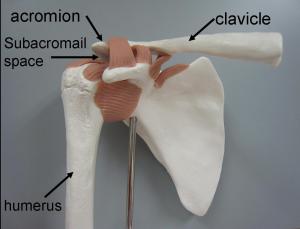


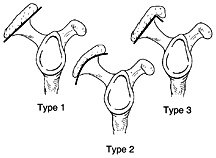
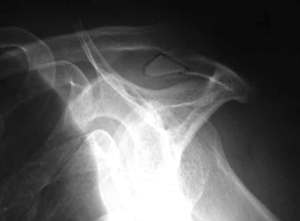
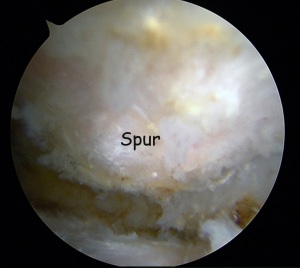
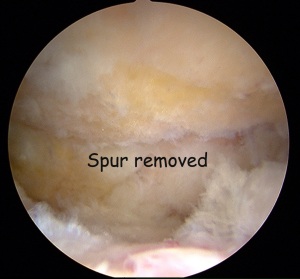
I am needing answers. I feel as though I’m just being juggled around MRI report states. There does appear to be discontinuity of portions of articular surface fibers of the supraspinatus tendon just proximal to the insertion of the humeral head on these sequences suggesting at least a partial thickness tear, but no large full thickness tear or tendon retraction is appreciated. Subscapularis, Teres minor, infraspinatus are intact..type II acromion no os acromiale. There appears to be irregularity of the anterior and superior Labrum with some extension into posterior labrum where there is abnormal intrinsic heterogeneous t2 signal which could indicate labral tear
Impression: 1 suboptimal evaluation on fluid sensitive fat saturation sequences with suspected at least partial tear of supraspinatus tendon.
2. Possible labral pathology as above
Orthopedist sees the results and discs and recommended I go to a neurologist.
Do I need to see one or get second opinion
The MRI suggests a partial articular sided supraspinatus tendon avulsion (PASTA Lesion). That can result in shoulder pain. If you have shoulder pain then I suggest you seek a second opinion.
Good day can this result in pain transferring to just about every muscle? Like my bicep head, forearm, outer pec, trap and of course the anterior posterior medialike deltoid muscles . I’m not even sure where the problem stems from anymore as there are so many trigger points. …..
Hi,
If the pain is global and around the shoulder region, consider adhesive capsulitis – frozen shoulder.
Regards,
hc
I am a Chiropractor and have been having shoulder pain. My Dr. recommended an MRI which showed: Substantial effusion of the subacromial bursa, especially the posterior recess, some abrasion or stranding of the surface of the cuff and an anterior acromial spur and thickened coracoclavicular ligament. He is recommending a cortisone injection or surgery. What would you recommend?
Dear Janine,
Cortisone injection will solve the pain. However, the effects may not be long lasting. In some patients, they have long lasting pain relief, in others, the pain will return after a period of time.
Surgery will provide a permanent solution to the impingement pain from the acromial spur.
In my practice, I usually explain the above to my patient. Usually they will have 1 cortisone injection to the subacromial space. If the pain recurs, then surgery is done.
I hope this helps.
Regards,
hc
I just had the surgery done for acromion impingement and surgeon found my biceps was torn as well. Also had surgery done sane time for nerve impingement in my elbows. My hands still go totally number though. Wonder if that will come right over time ?